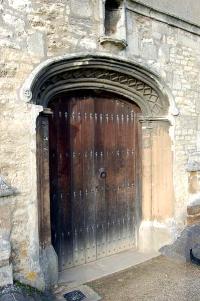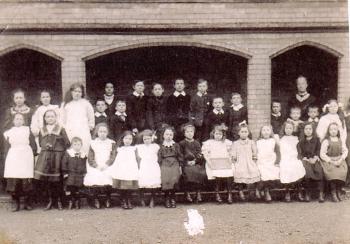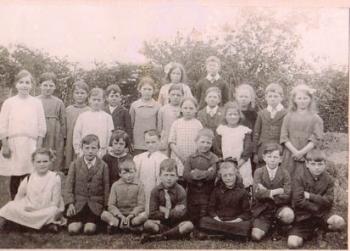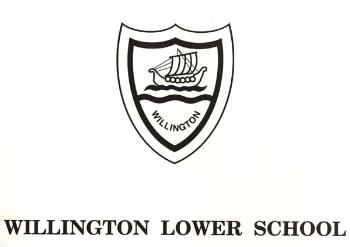Education in Willington

Early Education in Willington
The Bishop of Lincoln carried out visitations to Bedfordshire in 1717 and 1720 and for both of these a list of questions was sent out in advance, one of which enquired about the provision of schools in each parish. At this time it was reported to the Bishop that there was no schooling available for poor children in Willington.

Willington Lower School in November 2006
19th Century Education in Willington
In 1818 a Select Committee was established to enquire into educational provision for the poor. This was no doubt prompted, in part, by the recent foundation of two societies promoting education and specifically the building of schools. The Society for Promoting the Lancasterian System for the Education of the Poor was established in 1808 promoting schools run along the lines pioneered by Joseph Lancaster, who had himself copied those of Dr.Andrew Bell, in which older children taught their younger fellows. The Society was renamed the British and Foreign School Society in 1814,. It was supported by a number of prominent nonconformists, Lancaster himself was a Quaker, and sought to teach a non-sectarian curriculum. In answer to this perceived nonconformist takeover of local education the National Society was formed in 1811 to encourage the teaching of poor children along Anglican lines, including the catechism. The Select Committee sent a questionnaire to all parishes in the country asking for: particulars relating to endowments for the education of children; other educational institutions; observations of parish needs etc. The Willington return noted six boys from the parish went to a charity school in Cople. There was a small Sunday school which was attended by around 40 children. At this date Sunday School meant just that, school held on a Sunday at which such subjects as reading and writing were taught as well as the religious education which is its sole prerogative today. J.H. Bowers, the curate wrote that, ‘The poor, being generally employed in lace-making, might prefer employment to education. The Sunday school has been necessarily abandoned in winter, for want of a proper master, but the minister is going to resume it, and hopes to make it permanent.’ Another Sunday school was started in 1832 and was attended by about 35 children. It was supported by subscriptions from the curate, rector and others; the master was paid from this money.
The 1851 Educational Census recorded one Sunday school with 22 boys, 19 girls. The Willington Church of England School was built by the Duke of Bedford and opened in 1868. A year later an inspector described it as "a promising school" [Micf38/12].

A Willington school class about 1907
The first Education Act was passed in 1870 (more correctly it was known as the Elementary Education Act). It was a milestone in the provision of education in Britain demonstrating central government's unequivocal support for education of all classes across the country. It also sought to secularise education by allowing the creation of School Boards. These were groups of representatives, elected by the local ratepayers and the Board had the powers to raise funds to form a local rate to support local education, build and run schools, pay the fees of the poorest children, make local school attendance compulsory between the ages of 5 and 13 and could even support local church schools, though in practice they replaced them, turning them into Board run schools (known as Board Schools). Naturally, and luckily for local historians, the Act required a questionnaire of local schools in 1870. For Willington it was recorded that there was space for 130 children in the village school. In 1875 the running of Willington School was taken over by an newly formed School Board. Interestingly, decisions made by school boards included the provision of religious instruction which in Willington meant that from 1878: ‘The Bible is read and historically explained (Old Testament and New Testament, on alternate mornings), from 9.10 to 9.45 am each day the schools are open.’
A survey of Bedfordshire schools was carried out in August 1879 under the Factory & Workshop Act 1878 when the population of Willington was recorded as 275. The school, which was mixed, had 47 children on the books. The breakdown by age was as follows (boys/girls):
under 5: 1/3;
5-10: 19/18;
10-14: 3/3;
aged 14: none
The school log books show the kinds of equipment that the children used and the sorts of lessons that they were taught. In May 1887 the school received 2 dozen copy books, 3 dozen exercise books, 1 ½ dozen Little Readers, 1 box of slate pencils and half a gallon of black ink. Lessons too were different to today. A list of 25 proposed Object Lessons for 1897 included:
1. The cow
2. The elephant
16. Boots and shoes
18. A Butchers shop
23. A clock
[Micf 38/12]

A school class from the first half of the 20th century
20th Century Education in Willington
A land mark Education Act was passed in 1902, coming into effect in 1903. It disbanded the School Boards and gave day to day running of education to newly formed Local Education Authorities, usually the county council, as in Bedfordshire. The old Board Schools thus became Council Schools whilst the old National, British and other non-Board schools became known as Public Elementary Schools. The Board School in Willington duly became a Council School.
Bedfordshire & Luton Archives & Records Service has a number of school inspection reports for the period just before World War One and then between the wars [E/IN1/1]. The School Inspector's report for 1911 recorded the following comments for the junior mixed department "This small Village School continues to be carefully, conscientiously and well taught. Order and tone are all that can be desired. The whole written work deserves praise for its neatness and accuracy and both Drawing and Needlework are very creditable". However, as for the infants "The level of attainment in the Infants' Class is not high but the present Teacher has only been in charge a few weeks. She has made a good beginning, the methods are good and there are signs of improvement already". The mixed department continued to receive praise in following reports, as did the infants' department under its new teacher. In 1925 its was recorded that "This is an interesting School to visit, as the scheme proposes much more individual work than is usual in Schools of this type and there are difficulties in the presence of backward or abnormal children which do not allow the good points to be evident at first sight. But there is much real good in the development of these very children [and] in the clear progress of many of those who are more intelligent…"
In 1927 properties in Willington were valued under the 1925 Rating Valuation Act and the schoolhouse was recorded as being of brick and slate and comprising a parlour, living room and kitchen downstairs with three bedrooms above; it had a porch outside and property was - in the valuer's opinion - "v. good"
In 1928 the report began "The Head Teacher of this little school has high ideals" but went on to level a number of specific criticisms. The 193o inspection noted "This school was decapitated and became a Junior Mixed Department in September 1930. The work is gradually improving from that which was done during the last few months of the tenure of the last Head Teacher when the school was mixed". This improvement continued, as noted in 1934 and by 1937 the infants department had been brought back and the report noted "This Junior School, with Infants, is admirably managed…The atmosphere is that of a happy family party and it is a pleasure to visit the school".
During the Second World War 25 children from Rye [Sussex] were evacuated to Willington and attended the school. The entry in the log book for 8th August 1940 reads: "The local and evacuee children have been merged and arranged into classes" [Micf 38/12].
The third of the great Education Acts was that of 1944 which established the principle of County Primary Schools for children up to the age of 11, at which time they took an examination to determine the nature of the secondary school they would attend until they were 15, the most academically able going to grammar schools, the rest to secondary or secondary modern schools. The act also created two types of successor to the public elementary schools - the Voluntary Aided and Voluntary Controlled schools. Voluntary Aided schools are those in which the Local Education Authority funds the school but the governing body is independent, they are usually Anglican or Roman Catholic schools. Voluntary Controlled schools own their own buildings whilst the staff are employed directly by the governors. The school duly became a County Primary School. An inspector's report for 1956 [E/IN1/2] reveals that the school had two teachers and 36 children aged 5 to 11. It has "a cheerful atmosphere, aided by gay, colourful walls and good displays of pictures, books, apparatus and nature tables…[it] is one in which the children can and do work happily". The only criticisms were of the penmanship of the older children, setting out of written work in arithmetic and of the comparative lack of music teaching.

In the 1970s Bedfordshire County Council introduced comprehensive education, doing away with the 11+ examination and grammar schools and introducing a tier of school between the old County Primary and County Secondary Schools. Thus Lower Schools now taught children aged 4 to 9, Middle Schools from 9 to 13 and Upper Schools from 13 onwards. Willington cecame a Lower School for children. It had a new classroom added to the 1867 building to bring the total number of classrooms up to three. The numbers on the school roll had not changed significantly in over a hundred years - the estimated numbers for 1995 (in the prospectus of 1994 - E/Pu4/4/70) being 49.
Sources
- Willington Lower School pamphlet;
- CRT130WIL12: outline history of the school;
- R3/3703: Duke of Bedford's estate correspondence notes need to write about school in Willington: 1831;
- R3/3732: contract and cost of school: 1832;
- P26/29/3: account book for day school combined with Sunday School from 1860: 1858-1913;
- Micf38/12: mcirofilmed logbooks: 1868-1975;
- X535/1 p.128: list of schoolmistresses: 1868-1942;
- E/SA3/1/1: details of pupils tabulated under Factory & Workshop Act 1878: 1879;
- X535/1 pp.132-133: school treat: 1893;
- X535/1 pp.134-139: 11 photographs of pupils and staff: C20th;
- X535/1 p.140 pencil drawing of school house: C20th;
- E/TE5/1: details of teachers: 1904-1908;
- CTM17/27: mortgage of school premises: 1906;
- E/TE5/2: details of teachers: 1908-1912;
- E/IN1/1: inspector's reports: 1911-1937;
- SMM7: Elstow group of schools, managers' minutes: 1922-1974;
- CS/SPL2340: lease of school house: 1944-1962;
- E/IN1/2: inspector's report: 1956;
- CA2/262: extensions: 1964-1975;
- CA8/1009: school maintenance file: 1965-1984;
- SMM41/1: school managers' reports: 1974-1980;
- PY/PH164/1-2: slides of exterior of school: c.1980;
- E/TE3/4: return of teaching staff: 1981;
- E/SC1/Gen6: details of school: 1981;
- E/PM6/2/4: school support for abolition of corporal punishment: 1985-1986;
- E/TE3/7: return of teaching staff: 1986;
- E/MS3/2/3: kitchen and other details: c.1987
- E/Pu4/4/70: prospectus: 1995